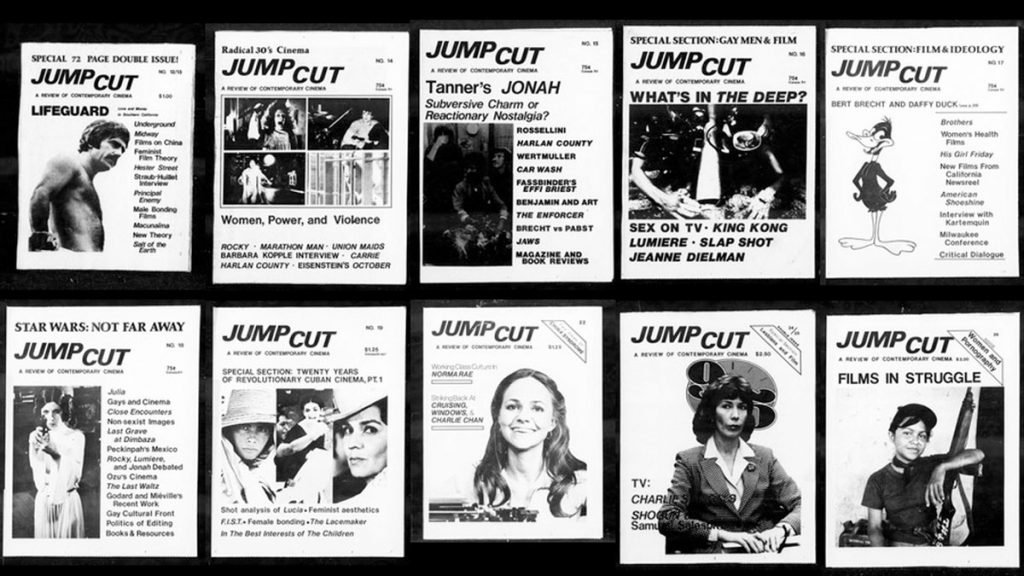“Jump Cut” is a model for open access journals. When the Internet Archive digitized older issues of “Jump Cut” from microfilm, we found that it had already been posted, in textual form, by the publisher. When we reached out to see if we could open up the microfilm version for free public access and download, they were enthusiastic. Here we wanted to share more background on “Jump Cut” and why openness is important for them.

From the beginning, Jump Cut was all about being accessible and uncensored.
Now, the alternative media criticism journal has achieved maximum exposure: All of its back issues are available digitally for free through the Internet Archive.
John Hess, Chuck Kleinhans, and Julia Lesage launched the publication when they were graduate students at Indiana University in 1974. At first, they produced it themselves on typewriters and distributed it on inexpensive, tabloid newsprint.
“It was positioned as a counter-culture journal. Their impetus for creating it was to provide a voice to the disenfranchised, those not normally published in academic journals,” said Jeremy Butler, professor emeritus of TV and film studies at the University of Alabama. “This has involved writers from left perspective, underrepresented people of color, LGBTQ writers and others.”
Jump Cut has never accepted advertising and being independent has always been its driving principle. It is a cross between an arcane scholarly journal and a pop culture film criticism magazine that covers a range of topics, such as pornography, that would be considered taboo in mainstream publications, said Butler, who has written for the journal himself.
The journal uses language that is familiar to academics, but not too obscure as to turn off readers. As a peer-reviewed journal, Jump Cut is an avenue for scholars—particularly junior faculty with diverse perspectives—to publish and earn citation credits.
In 2004, the journal moved online and discovered an international audience. After Hess and Kleinhans died, Lesage wanted to preserve the publication’s history and plan for its future.
“There’s so much that’s invisible in our culture, so much that’s hidden behind structural and class divides.”
Jeremy Butler, professor emeritus of TV and film studies at the University of Alabama
Butler, who was a doctoral student of Kleinhans at Northwestern University and recently retired from Alabama, helped Lesage convert and archive some of the text from older issues of Jump Cut. The Internet Archive provided a home for the files as an institutional host. Recently, as part of a microfilm digitizing effort, the Archive scanned images, photos and text from all 59 issues of Jump Cut and made them available in a collection.
“Our goal was always to reach as many people as possible,” says Lesage, who says she was “totally ecstatic” to learn the entire collection was preserved by the Archive. “Now people will be able to see the images that we ran with those early articles.”
In addition to the journals, Kleinhans and Lesage have had syllabi and lecture notes from a variety of film and media courses they taught digitized and added to the Internet Archive collection. “I’ve tried to encourage scholars to archive their own papers and research materials,” says Lesage, who hopes the collection will be used by students, teachers and researchers. “It’s a treasure that scholars should take advantage of and not leave it to their heirs to try and decide what to do with all these boxes of papers.”
Butler, who is a regular user of the Wayback Machine, movies and audio files through the Archive for his own research and enjoyment, said preserving the course materials and the complete Jump Cut collection is exciting for scholars and the public at large.
“It provides access to voices that people would not normally hear,” Butler said of broader new availability of the media studies journal. “There’s so much that’s invisible in our culture, so much that’s hidden behind structural and class divides. Jump Cut has prided itself on providing a voice to the unspoken…It might open up a whole new world to readers that they never even knew existed.”
Hi there why did Microfilm stop.
Hi ChickaDEE Magazine:
Microfilm stopped because there were successor technologies which were more cost-efficient at the user and library level.
[for example: the Portable Document Format does a lot of the job of keeping graphics and videos safe; secure and private – the disadvantage is commercial licensing].
Also the machines are hard to use for the ordinary researcher.
And if you were to misplace a film it would be very hard to find indeed.
Still, microfilm was part of life into the 2000s and 2010s.
[and students used it in the 1990s which is how I know it – in both the school and local libraries and again in journalistic morgues].
Are you interested in JumpCut and other magazines?
And I wonder if you have your material on microfilm/microfiche.
Adelaide